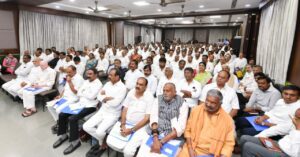The Gruha Saradhi network is being seen as a similar network of the BJP, that helped the saffron party win election after election.

Andhra Pradesh Chief Minister YS Jagan Mohan Reddy. (Supplied)
Andhra Pradesh Chief Minister and YSRCP supremo YS Jagan Mohan Reddy has laid out an ambitious plan to have an extensive and expansive ground network that micromanages voters and brings them to the polling booth on the day of the election.
He has decided to have a strong party network of 5.2 lakh “Gruha Saradhis” across the 15,000-odd villages in every nook and corner of Andhra Pradesh.
There will be 45,000 conveners who will coordinate the party work with them.
“For every 50 families in the state, one male and one female party cadre will be in charge. They are called ‘Gruha Saradhi’,” Jagan told a meeting of the party constituency observers, district presidents, and regional coordinators at his camp office recently.
“They will carry the party message besides providing publicity materials,” he added
The Gruha Saradhi network is being seen as a similar network of “Panna Pramukh” — head of a page in the electoral rolls of the BJP — that has been helping the saffron party win election after election, especially in Uttar Pradesh and the recent polls in Prime Minister Narendra Modi’s home state Gujarat.
The BJP has a strong grassroots network of booth pramukhs, panna pramukhs and panna samitis across the country.
Meanwhile, the newly launched government ward/village secretariats and volunteer system have come in handy for the ruling YSRCP to deploy the network.
“Under the village and ward secretariats, there will also be three convenors for the party and at least one of them should be a woman. Those having political awareness and are active should be appointed as conveners,” said Jagan.
“There will be 45,000 convenors in all the village and ward secretaries. Initially, three convenors should be appointed for 15,000 secretariats who will later appoint in-charges for assembly constituencies. The party observers will ensure the implementation of the process in a proper manner,” he added.

YSRCP’s constituency observers, district presidents and regional coordinators at a meeting held at chief minister YS Jagan Mohan Reddy’s camp office on Thursday. (Supplied)
As the Gadapa Gadapa Ki Mana Prabhuthvam programme nears completion, the YSRCP supremo wants the “Gruha Saradhi” network cadres to meet at least 1.6 crore families in just 10-15 days.
“By the time the polls arrive, these saradhis will go and meet multiple families under their cluster. This way the families and voters will be constantly reminded about the government programmes as the Saradhis will keep on interacting with them on a day-to-day basis. We have also developed a system to monitor the activity,” said a senior functionary of YSRCP.
IPAC, which conducted several such grassroots-level party activities and poll campaigns in the run-up to the 2019 polls, designed the ‘Gruha Saradhi’ concept and is expected to ensure that the ground network interacts with the families in their respective clusters.
In fact, IPAC Director Rishiraj Singh was also present in the meeting where Jagan had explained the Gruha Saradhis network to the party.
The meeting was called for an orientation to explain the action plan on how the regional coordinators, district party presidents and constituency observers should work in coordination to strengthen the party cadres from the grassroot levels.
“Such a network will ensure the target of 175 out of 175 seats. This network should be strengthened, and conveners should be appointed up to village and ward secretariat level,” said Jagan.
“Our hard work will yield the desired results. During our three-and-a-half-year term, 92 percent of the households in rural areas and up to 80 per cent in urban areas have benefitted from our welfare schemes. The regional coordinators should resolve any minor issues and the cadre should be united and take forward the good record of our governance to every household in the state,” he said.

Apr 24, 2024

Apr 24, 2024

Apr 24, 2024

Apr 24, 2024

Apr 24, 2024

Apr 24, 2024